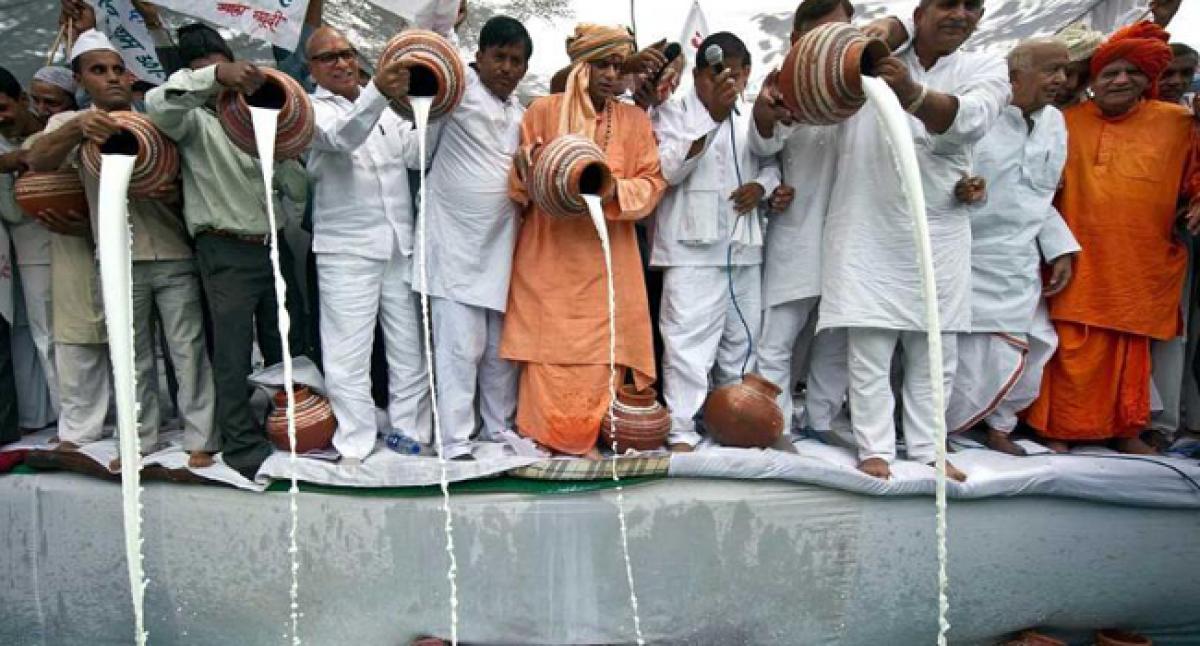Live
- Coach Gambhir’s stint riddled with setbacks, says Kaif
- Vaikuntha Ekadashi 2025: A Special Day to Pray to Lord Vishnu
- Smith to lead Oz against Sri Lanka
- Australian Open 2025: Djokovic, Alcaraz set for potential QF
- Meru Antaragni 2025: A fusion of art and sustainability
- India missed a left-arm seamer during BGT: Joshi
- Game Changer X Review: Fans React to Ram Charan’s Dual Role and Shankar’s Direction
- Haasini mesmerises with Carnatic performance
- Manisha Koirala shares the lessons she learned from her puppy
- Of six dead, four belonged to undivided Visakhapatnam
Just In

The milk producers are up in arms The price of milk in the market is declining Unable to get a reasonable price, they have often dumped milk in the drains First let us examine why the solutions often proposed have not worked in the last many decades and are not likely to succeed now
The milk producers are up in arms. The price of milk in the market is declining. Unable to get a reasonable price, they have often dumped milk in the drains. First let us examine why the solutions often proposed have not worked in the last many decades and are not likely to succeed now.
The first solution proposed is that the excess milk can be exported. The Government has recently increased the export subsidy to about Rs 8 per kilo on skimmed milk powder (SMP). But this subsidy is like a drop in the ocean.
Reportedly, SMP from New Zealand is selling in the international market at Rs 134 per kilo while the cost of production indicated by Indian dairies is Rs 180. Moreover, the New Zealand SMP is considered to be of better quality than the Indian product. Thus it would require a hefty subsidy of about Rs 50 per kilo to actually push exports in a big way. The budgetary impact of such a subsidy would not be bearable.
The United States was exporting large amounts of milk products such as SMP, cheese and butter to China and Mexico. The ongoing trade war between these countries has led to the latter countries imposing higher import duties on American dairy products. This seems to provide an opportunity for India to step into the shoes of the US. However, as said above, New Zealand and Australia are better positioned to step in.
The global prices are likely to fall further due to this trade war. The price of dairy products in the US has declined after the imposition of the duties by Mexico and China. The American government has stepped in and started buying butter and cheese in large quantities just as our Food Corporation buys wheat from the farmers. Butter has a shelf life of about 3 months and cheese about 18 months.
The question is where will the US Government dispose these stocks? Such a situation had developed few years ago. At that time, President Obama distributed these free to the elderly and gave away these products as foreign aid. Such distribution, in part, reduces the demand in the market. The American elderly and the African aid recipient were previously purchasing some dairy products from the market.
They would purchase less now since they are getting some free from the US Government. This reduced demand will lead to lower prices in the international markets and make it more difficult for India to export.
Another solution proposed is that India should shift from exports of SMP to higher value produce such as butter and cheese. However, the price of these products increases and decreases in tandem with the price of milk. Their export too would require hefty subsidies. Yet another solution proposed is that the Government can introduce futures trading in dairy products.
The farmers would then get an early indication of the future price and adjust the production accordingly. This is true. But this does not help raise the future price—which is needed to secure farmer’s welfare.
Another solution being proposed is that the Government can build a buffer stock of these milk products. However, we have seen the fate of large buffer stocks of wheat that were held by the Food Corporation of India. The Supreme Court had asked the Government few years ago, why the wheat should not be distributed to the poor instead of letting it rot in the open storage yards of the FCI? Buffer stocks cannot help contain a long term decline in prices such as we are seeing at present.
Another solution proposed is that the surplus milk or SMP can be distributed at a subsidized price to the BPL households. Karnataka has, for example, launched a ‘Ksheera Bhagya’ scheme under which government school kids across the state are being given milk free of cost. This is a viable solution. However, as said above, the benefit to the farmers will be small. The demand for milk in the market will reduce and the benefit to the farmer will be undone.
There are no easy solutions. The prices of agricultural produce are declining globally. The global production of agricultural products is increasing rapidly due to the adoption of new technologies while the demand is only inching forward because population growth has slowed down. This is the reason that the developed countries often pay farmers for not cultivating their lands.
In this way the farmer is directly benefitted and the production is also reduced. My suggestion is that we must similarly pay the money to the farmers directly rather than through export subsidies. Let us say, the Government gives a subsidy of Rs 25 per kilo on the SMP. The farmer exports his milk on the back of this subsidy. The profit obtained by the farmer from this export, I reckon, would be Rs 15. So the Government would be paying Rs 25 to reach Rs 15 to the farmer. It would be better to pay Rs 25 to the farmer directly.
The share of agriculture in the income of developed countries like the US has declined to less than one percent today. The share of services is about 90 percent and the share of manufacturing is about 9 percent. We are moving in same direction. The share of agriculture in our income at the time of Independence was about 50 percent. It has declined to less than 20 percent today. Therefore, trying to help the farmers by giving out export subsidies is like installing a bigger pump in a sinking boat.
The way forward is to use the higher qualities of countryside. This can be explained by two examples. The forest has two uses. We can cut the trees and sell the timber. Alternatively, we can develop tourism as we have done in wildlife sanctuaries. The market of timber is getting smaller while the market of forest tourism is getting bigger. Or consider our river.
We can build dams and use their water to generate electricity. Alternatively, we can develop recreational opportunities such as rafting and fishing. The market for electricity is moving south while that of tourism is moving north. We must apply the same formula in agriculture. We should develop the tourist potential of our villages by supporting homestays and developing eco- and cultural tourism.
We should make efforts to shift our population from agriculture to services that can be supplied internationally through the internet such as tuitions, legal research, and design. The decline of agriculture cannot be prevented. We can only help the farmers to shift to the services sectors that are ever growing. Author was formerly Professor of Economics at IIM Bengaluru

© 2025 Hyderabad Media House Limited/The Hans India. All rights reserved. Powered by hocalwire.com







